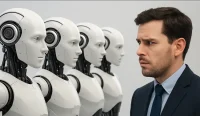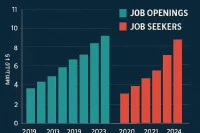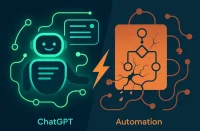Immigration and labor policy are once again at the forefront of national debate after recent comments from former President Donald Trump and Florida Governor Ron DeSantis reignited discussion around the use of foreign worker visas and international student enrollment. Both issues cut to the heart of a long-standing tension in U.S. economic and immigration policy: how to balance the needs of American workers with the demands of globalized industries and universities.
H-1B Visas Under Fire
The H-1B visa program was created in 1990 to allow U.S. employers to hire foreign workers in specialized fields, particularly in science, technology, engineering, and mathematics. Each year, about 85,000 new visas are issued, though renewals and extensions push the total number much higher. In 2023, roughly 400,000 H-1B workers were employed in the United States, a number that critics say represents lost opportunities for American professionals.
Supporters of the program, including many Silicon Valley firms, argue that H-1B visas provide access to top global talent and help U.S. companies stay competitive in fast-moving industries. But detractors say the program is widely abused.
Governor DeSantis, speaking in an interview this week, sharply criticized the program. “Companies are laying off Americans while continuing to bring in new H-1B workers,” he said. “It’s a scam that keeps wages down and limits opportunity for our own young people, especially as artificial intelligence reshapes the workforce.”
Industry analysts acknowledge that many of the largest visa holders are multinational tech giants such as Amazon, Google, Microsoft, Apple, and Meta. These firms argue that their demand for skilled workers cannot be met through the U.S. labor pool alone, but critics accuse them of using the system to secure cheaper labor.
Labor advocates have described the H-1B system as resembling “indentured servitude.” Because workers are tied to one employer, they have little bargaining power to seek higher wages or better conditions. DeSantis echoed that view, saying, “H-1Bs limit the worker to that one company. They want portability taken away so they can keep costs down.”
Trump’s Position: Restrict Visas, But Make Exceptions
During his presidency, Trump frequently denounced the H-1B program, framing it as a threat to American workers. His administration imposed new rules tightening eligibility and increasing oversight. However, Trump also courted business leaders, creating occasional contradictions in his stance.
This week, Trump defended his broader economic record but faced questions over whether his visa policies matched his “America First” rhetoric. The former president has signaled support for restricting H-1Bs but has occasionally expressed flexibility when pressed by large companies that rely heavily on foreign labor
Need Skilled Talent Amid Visa Uncertainty?
Post your job on WhatJobs and connect with qualified professionals ready to fill critical roles—no matter the policy shifts.
Post a Job Now →Chinese Student Enrollment: Another Flashpoint
Alongside the H-1B debate, international student enrollment has become another focal point. Nearly 380,000 Chinese students are currently studying in the U.S., according to data from the Institute of International Education. They represent the single largest group of foreign students in American universities, contributing billions in tuition revenue each year.
Trump recently suggested allowing as many as 700,000 Chinese students into U.S. schools, nearly doubling the current figure. He argued that without their tuition payments, many colleges would struggle financially.
“Our college system would go to hell very quickly without them,” Trump said.
Governor DeSantis, however, expressed concern about the idea, pointing to both economic and security implications. “To put it in perspective, Florida’s entire state university system has just over 300,000 students. Adding 700,000 Chinese students nationally would be extraordinary,” he said.
DeSantis added that some Chinese students may have ties to the Chinese Communist Party, raising questions about espionage and influence. “The old belief was that bringing students here would create goodwill ambassadors for America when they returned home. That hasn’t happened,” he argued.
Universities Depend on International Tuition
For universities, international students—especially those from China and India—are a crucial financial lifeline. Unlike many American students, they often pay full tuition without relying on scholarships or government aid. At some institutions, particularly public universities facing budget cuts, international tuition has become essential to keeping programs afloat.
A recent study by the National Foundation for American Policy found that international students contribute nearly $40 billion annually to the U.S. economy, supporting more than 450,000 jobs nationwide. Yet this dependence has created vulnerability.
“Colleges have become addicted to full-tuition-paying foreign students,” said policy analyst Abigail Thompson. “It raises questions about sustainability and fairness, especially when domestic students struggle with rising costs.”
Some experts argue that sharply reducing foreign student enrollment would cause financial crises for many universities, forcing program cuts and layoffs. Others suggest the solution lies in expanding financial aid and making college more affordable for U.S. citizens, reducing the need to recruit internationally.
Political Divide and Public Opinion
The visa and student enrollment debates highlight the broader divide in American politics over globalization. Conservatives often argue that visas undercut U.S. workers and that universities prioritize profits over national interests. Business groups, meanwhile, maintain that foreign workers and students are vital for innovation and economic growth.
Polls reflect public skepticism. A 2024 Pew Research survey found that 62% of Americans believe corporations exploit the H-1B system, while only 28% believe it primarily benefits the economy. Similarly, more than half of respondents expressed concern about the number of Chinese students in U.S. universities, citing both job competition and national security risks.
Economic Context: AI and Labor Market Shifts
The debate comes at a time when artificial intelligence is reshaping the labor market. Analysts warn that automation could displace millions of jobs over the next decade, particularly in white-collar professions traditionally associated with college graduates.
In that context, critics ask why the U.S. should continue importing workers through H-1B visas. Supporters counter that AI development itself requires top global talent, much of which comes from abroad.
“There’s a paradox here,” said labor economist David Klein. “AI is reducing demand for some roles, but at the same time creating explosive demand for others, especially in software engineering, data science, and cloud infrastructure. Cutting visas may hurt competitiveness in those areas.”
Looking Ahead
Both the H-1B and international student issues are likely to remain central in the 2024 election season. Trump has made immigration a cornerstone of his platform, while DeSantis has sharpened his critique of corporate practices. Democrats, for their part, remain divided, with some calling for stronger labor protections and others warning against isolating the U.S. from global talent flows.
What is clear is that immigration, education, and labor are increasingly intertwined in a debate that reaches far beyond Washington. For American workers, students, and businesses, the stakes remain high.
FAQs
1. What is the H-1B visa program?
The H-1B program allows U.S. employers to temporarily hire foreign professionals in specialized fields such as IT, engineering, and medicine. Workers are tied to their sponsoring employer and can remain in the U.S. for up to six years.
2. Why do critics say the program hurts American workers?
Critics argue that companies use H-1B visas to secure cheaper labor, displacing U.S. workers and depressing wages. Because employees are tied to one company, they have less bargaining power, leading some to describe the program as exploitative.
3. How many Chinese students study in the U.S.?
Roughly 380,000 Chinese students are currently enrolled in American universities, representing about one-third of all international students. Trump has suggested allowing as many as 700,000, sparking debate about national security and university dependence on tuition revenue.




